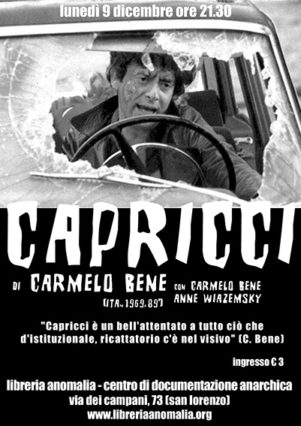 An unrestrained phantasmagoria from Italy’s Carmelo Bene, one of the world’s most defiantly idiosyncratic filmmakers. It may not be his best work, but it is quite representative: vulgar, hysterical and like nothing else.
An unrestrained phantasmagoria from Italy’s Carmelo Bene, one of the world’s most defiantly idiosyncratic filmmakers. It may not be his best work, but it is quite representative: vulgar, hysterical and like nothing else.
…vulgar, hysterical and like nothing else.
The multi-talented Carmelo Bene seems better known, at least in his native Italy, for his novels and plays than for his filmmaking. That’s a shame, as his five features (the last of which was made, sadly, in 1975) rank among the most fascinating and distinctive ever made. Of course, it’s doubtful that Bene’s peculiar brand of cine-lunacy would ever find financial backing nowadays, much less a receptive audience.
…his five features (the last of which was made, sadly, in 1975) rank among the most fascinating and distinctive ever made.
Made in 1969, CAPRICCI, Bene’s second film, is, like its predecessor NOSTRA SIGNORELLA DEI TURCHI (OUR LADY OF THE TURKS), a hallucinatory, non-linear, and ultimately apocalyptic look at life in “modern” Italy. Unlike Bene’s best work (NOSTRA SIGNORELLA DEI TURCHI) and the mind-roasting SALOME (which may just be the craziest movie I’ve ever seen), CAPRICCI has not dated particularly well. The violent series of car accidents that climax the film, for instance, might have seemed shocking back in ‘69, but nowadays they play like slow outtakes from NASH BRIDGES. Likewise, a “scandalous” look at a transvestite love affair feels contrived and plain silly. That’s NOT to say CAPRICCI isn’t worth seeing. It is, after all, utterly unique, and a fascinating time capsule showing just how weird movies got in the late 60’s, arguably the cinema’s last “golden age.”
CAPRICCI has no “story” to speak of, just a series of surreal vignettes. It begins with a dissatisfied Communist (played by Bene himself) getting into a dual with a superior; they fight with, appropriately enough, a hammer and a sickle. An old man lies in bed beside an alluring naked women; making noisy rasping sounds, he tries to have sex with her (and has about as much success as Bene did in NOSTRA SIGNORELLA DIE TURCHI, where he tried to screw wearing a suit of armor!). Bene and a lady companion make out furiously in the back of a smashed-up car (intimations here of CRASH). And so on.
CAPRICCI has no “story” to speak of, just a series of surreal vignettes.
The Italian novelist Alberto Moravia has described Carmelo Bene’s work as “desecration by disassociation, pushed beyond the point of schizophrenic delirium.” I’ll buy that. Disorientation seems to be Bene’s primary goal, evinced in the fast, jagged cutting and his preference for waving things in front of the camera lens. Scenes are more often than not structured around their visual essence, with logic and storytelling being the last thing on the director’s mind-–Bene’s pictorial sense is so striking he gets away with an approach that most Hollywood directors would love to fall back on (but can’t). Add to that a preference (evident in all his films) for sentimental arias and you’ve got one bizarrely impressionistic film, one that must simply be experienced rather than “understood.”
The Italian novelist Alberto Moravia has described Carmelo Bene’s work as “desecration by disassociation, pushed beyond the point of schizophrenic delirium.” I’ll buy that.
Vital Statistics
CAPRICCI
Director: Carmelo Bene
Screenwriter: Carmelo Bene
Cinematography: Maurizio Centini
Editor: Mauro Contini
Cast: Carmelo Bene, Ornella Ferrari, Anne Wiazemsky, Poldo Bendandi, Piero Vida
